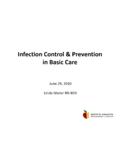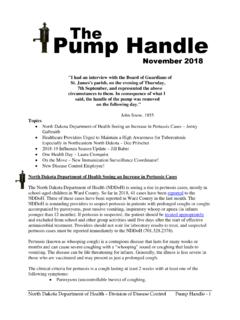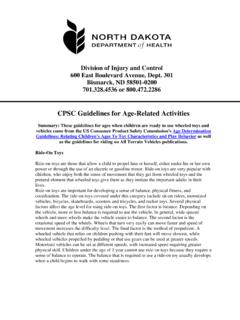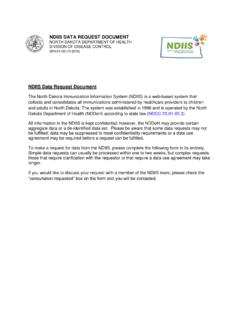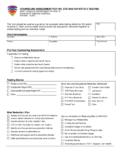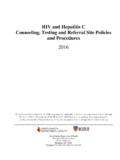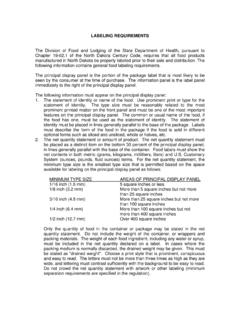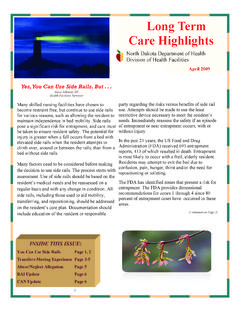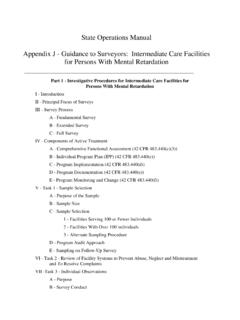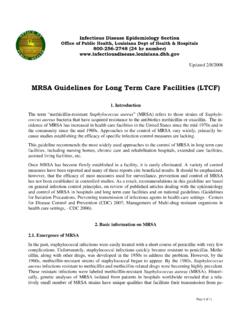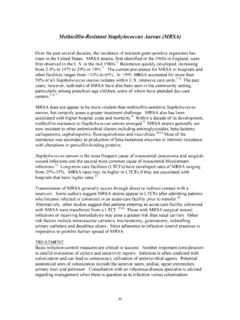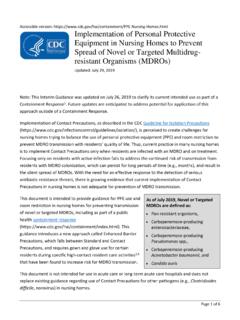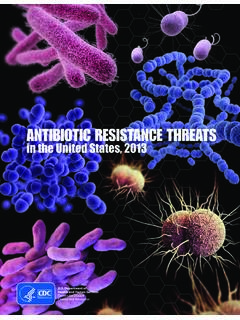Transcription of Multi-drug Resistant Organisms (MDROs) in Healthcare ...
1 Gail Bennett RN, MSN, CIC1 Multi-drug Resistant Organisms (MDROs) in Healthcare FacilitiesWhat we will cover: General information Specific MDROs Methicillin Resistant Staph aureus(MRSA) Vancomycin Resistant Enterococci (VRE) Extended Spectrum Beta Lactamase Producers (ESBLs) Klebsiella pneumoniaecarbapenemase (KPC) ResistantAcinetobacter baumannii2 Surveillance for MDROs control Measures Isolation precautions Hand hygiene Environmental decontamination Antimicrobial stewardship programs3 What we will cover:4 Emergence of Antimicrobial ResistanceNew Resistant BacteriaSusceptible BacteriaResistant BacteriaResistance Gene TransferMethicillin- Resistant Staphylococcus aureus (MRSA) MRSA emerged in the US soon after Methicillin became commercially available in the early 1960 s with the first case being detected in 1968.
2 Increased prevalence in the 70s5 2000: MRSA accounted for 53% of all S. aureus clinical isolates from patients with nosocomial infections acquired in US ICUs (NNIS) 2003: the percentage had increased to (NNIS)6 The 1st identification of MRSA in LTCFs was in 1970 but it was uncommon in LTC until around Resistant to methicillin, oxacillin, and nafcillin Transmitted by direct and indirect contact No more virulent than MSSA Susceptible to common disinfectants8 Methicillin- Resistant Staphylococcus aureus (MRSA) Poor functional status Conditions that cause skin breakdown Presence of invasive devices Prior antimicrobial therapy History of colonization9 Risk Factors Contributing to MRSA Colonization/Infection for all Facility Types Male gender Urinary incontinence Fecal incontinence Presence of wounds Pressure ulcers Antibiotic therapy Hospitalized within the previous 6 months10 Specific Risk Factors for MRSA Colonization in LTCFs Heavy draining wound Incontinent, diarrhea.
3 Colostomy Cannot/will not contain secretions and excretions Very poor hygiene Difficult behaviors that may increase the risk of transmission Other11 What patients are more likely to shed MRSA and need contact precautions? Vancomycin is the drug of choice Disadvantages of Vancomycin expensive parenteral administration ototoxicity can potentiate nephrotoxicity of aminoglycosides12 Treatment Regimens for MRSA Infection Linezolid (Zyvox) has been an alternative to Vancomycin treatment of MRSA since 2000 Administered orally13 Treatment Regimens for MRSA Infection Do not routinely culture staff for colonization with MRSA It may be needed as part of an outbreak investigation HCW epidemiologic link to transmission Before culturing, Get expert consultation Have an action plan in place!
4 14 Colonization/carrier state of MRSA by Healthcare Workers Contact precautions with observation for compliance Hand hygiene If a decision has been made to culture staff for nasal colonization: Mupirocin has been shown to be somewhat effective. 15 Outbreak control 1st case in US, June, 2002, Michigan; 2nd case -September, 2002, Pennsylvania Vancomycin Resistant gene transferred from VRE in same patient To date, the US has had approximately 11 cases of VRSA CDC recommends private room, contact precautions Reportable to your state and CDC16 Vancomycin- Resistant Staphylococcus aureus Excellent document: CDC. Investigation and control of Vancomycin-Intermediate and Resistant Staphylococcus aureus(VISA/VRSA), September, Staphylococcus aureus Not routinely recommended for acute care, LTCFs, or other Healthcare facilities May be needed in an outbreak Must have an action plan before you start culturing I would suggest a consult with the state epidemiology office first18 What about surveillance cultures to find all patients/residents colonized or infected with Resistant Organisms ?
5 Active surveillance cultures: CDC says, More research is needed to determine the circumstances under which ASC are most beneficial but their use should be considered in some settings, especially if other control measures have been ineffective. CDC mdro Guideline, 200619 All admits from LTCFs, jails, prisons Anyone on dialysis ICU/CCU admissions CABG patients Orthopedic patients: total joint replacements Neuro: open back Wounds/cellulitis20 However, hospitals have a relatively new process for surveillance screening for MRSA -Example:Are hospitals screening all admissions for MRSA? No, only a small % of their admissions fall in their high risk categories and get do we isolate admissions to LTCFs from the hospital who were culture positive for MRSA in the nares?
6 No, not if that is the only site of MRSA identified We will be alert to the fact that the resident is colonized and alert to any new Healthcare associated MRSA cases should they develop22 Vancomycin- Resistant Enterococcus (VRE) Enterococcus faecalis Enterococcus faecium Contact Precautions - culture negative prior to discontinuing precautions? CDC now says we need to decide when to d/c precautions but it may be prudent to have negative culture(s) prior to d/c of isolation23 Environmental contamination24 Why contact precautions for specific Organisms ?~ Contaminated surfaces increase cross-transmission~Abstract: The Risk of Hand and Glove Contamination after Contact with a VRE (+) Patient Environment.
7 Hayden M, ICAAC, 2001, Chicago, VRE culture positive sites25 The Inanimate Environment Can Facilitate Transmission Aerobic gram-negative bacillus High level of resistance High numbers of A. baumanniiinfection among our troops in Iraq Causing outbreaks in Healthcare facilities Contact Precautions See attached example26 Resistant Acinetobacter baumannii27 Acinetobacter baumannii: Example microbiology reportAntimicrobialInterpretationAntimic robialInterpretationPolymyxin BSAmpicillin/sulbactamIAmpicillinRAztreo namRCephazolinRCeftriaxoneRTrimethoprim/ SulfaRCefepimeRGentamicinRCeftazidimeRTo bramycinRPiperacillin/tazobactamRLevoflo xacinRImipenemRExtended spectrum beta-lactamase producers (ESBLs) Gram negative Organisms -Enterobacteriaceae Excrete the enzyme beta-lactamase Inactivates -lactam (penicillin) type antibiotics Resistance to -lactams emerged several years ago and has continued to rise ESBLs Klebsiella E.
8 Coli Serratia others29 Urine culture -Klebsiella pneumoniaeAntimicrobialInterpretationAnt imicrobialInterpretationAmpicillinRCipro floxacinRAmpicillin/sulbactamRGentamicin SAztreonamRImipenemSCephazolinRNitrofura ntoinRCefepimeRPiperacillin/tazobactamIC eftazidimeRTrimethoprim/SulfaRCeftriaxon eR Fortunately, our most potent -lactam class, carbapenems, remained effective against almost all , Ertapenem, Imipenem, Meropenem Antimicrobial resistance follows antimicrobial use30 The Last Line of DefenseAntimicrobialInterpretationAntimi crobialInterpretationAmikacinIChloramphe nicolRAmox/clavRCiprofloxacinRAmpicillin RErtapenemRAztreonamRGentamicinRCefazoli nRImipenemRCefpodoximeRMeropenemRCefotax imeRPipercillin/TazoRCetotetanRTobramyci nRCefoxitinRTrimeth/SulfaRCeftazidimeRPo lymyxin BMIC >4 g/mlCeftriaxoneRColistinMIC >4 g/mlCefepimeRTigecyclineS31 Susceptibility Profile of KPC-Producing K.
9 PneumoniaeCDC - MMWRM arch 20, 200932 Klebsiella pneumoniae Carbapenemase (KPC) Guideline3334 Let s talk about precautions for Precautions Protect HCWs from spreading microorganisms by direct or indirect contact with resident or his environment Prevent transmission within the facility Contact precautions are the most common transmission-based precaution used in the acute care setting, probably dropletin LTCFs Consider use with infections caused by MDROs (in LTCFs we must make a case by case decision) Consider the contaminated environment especially with C. difficile and VRE36 Contact Precautions for MDROs in Acute Care Private room Contact precautionsCDC mdro guideline, 200637 Contact Precautions for MDROs in LTCFs CDC tells LTCFs to consider: the individual patient clinical situation prevalence or incidence of MDROs in the facilitywhen deciding to implement or modify contact precautions in addition to standard precautions for mdro infected or colonized healthy residents may need only standard precautions while ill residents and those where secretions/excretions cannot be contained may need contact precautions.
10 CAUTION: some MDROs require contact precautions even in LTCFs!CDC mdro guideline, 200638 Precautions in Ambulatory Settings CDC recommends standard precautions Remember: we always have the option of using gowns and gloves as needed even without contact precautions! Designed to reduce the risk of transmission of microorganisms by direct or indirect contact Direct contact skin-to-skin contact physical transfer (turning patients, bathing patients, other patient care activities) Indirect contact Contaminated objects Hands Equipment Clothing- potential exists for contaminated clothing to transfer infectious agents to successive patients New in the 2007 CDC isolation guidelines cannot re-use same isolation gown even on same patient 40 Contact Precautions Patient placement Private room OR Cohorting (two or more patients/residents in same room with same organism)
